In a previous article, I told the story of Martin Kaffitz and his wife Hattie W. Fritts. Kaffitz was employed for many years by William Crater who ran the blacksmith shop in Glen Gardner, Hunterdon County. I learned about the life of Martin Kaffitz from the many entries about him in the Hunterdon Republican newspaper. That paper was equally informative about William Crater, although Crater led a very different sort of life.
First, Some History of Glen Gardner
In 1828, the village of Glen Gardner was known as Sodom—as in Sodom and Gomorrha. Look it up in the Old Testament (Book of Genesis) if you’re not familiar with the term. This name was inspired by the village tavern that was first built in 1760 by John Eveland. His son Peter took over after 55 years, and his grandson John took over after another forty. 1 That would mean that son Peter was running the place when it got its unsavory reputation. Snell goes on to say that when a post office was established around 1820, the village name was changed to Clarksville, in honor of the postmaster at the time. But Thomas Gordon had not gotten the message, because his map of 1828 still shows the place as Sodom. The name Glen Gardner had only come into use shortly before Snell published his history in 1881. It was named for the Gardner family who owned much of the real estate in the village in 1873. The existence of the village owes much to Spruce Run (the creek, not the reservoir) and the local topography. It really is a glen, squeezed between high hills and the valley created by the creek. In early days, it was also an intersection of a north-south and a northeast-southwest road.
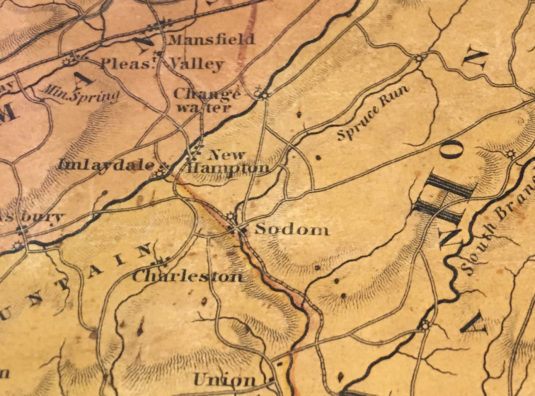
William Crater was born in February, 1824 to Philip Crater and Margaret Apgar of Lebanon Township. On May 17, 1845, he married his first wife Caroline Waters, and together they had seven children. Caroline Waters Crater died on January 31, 1877, when she was about 52 years old, and William married his second wife, Sarah Aller, two years later, on July 12, 1879.
William Crater decided on the occupation of blacksmith at an early age. In the 1850 census for Lebanon Twp. (where the village of Glen Gardner was located), William Crator was a 25-year-old blacksmith with property worth $600. His wife Caroline was 24, and their children were Margarett J., 3, and Mary E., 2.
In 1851, when the Cornell Map was published it showed property of “W. Crater” somewhat northeast of the central village of Glen Gardner. You can see Crater’s lot by looking between the E and the B in the name Lebanon. One of the Crater deeds described the road as “the road from Spruce Run to Crater’s farmhouse.” Another deed had his property “on the road from William Crater’s Shop to White Hall.”
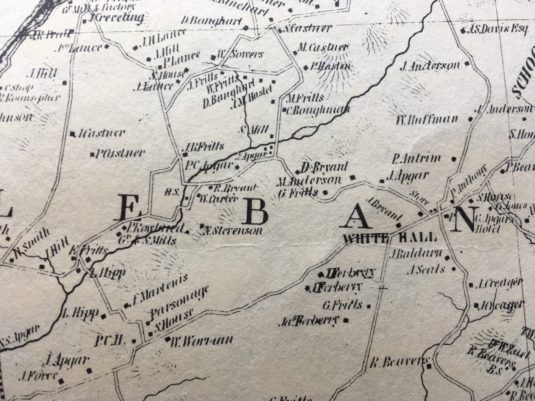
In 1859, Crater purchased three properties (from John Martenis, Leonard Hipp and his father Phillip Crater). This was reflected in the 1860 census in which the changes to the Crater household were an increase in the value of his property, up to $1,000 for real estate and $150 for personal property, and a change in the family itself. Daughter Margaret had died in 1853, age 6. Mary was called Elizabeth, now age 13, and three more children were added: George 10, Andrew S. 7, and Emma 3. Also in the household was Levi Davenport 18, who was identified as a blacksmith.
In 1862, Crater bought another lot, this time from Peter H. Rowland.2 After 1862, William Crater bought no more property. (Or if he did, he did not record the deeds.) But from 1864 to 1881, he sold several lots, sometimes under duress.
On October 1, 1862, William Crater’s father Phillip of Lebanon Twp. wrote his will.3 He left his household goods and livestock, plus interest from outstanding moneys, to his wife Margarett; as well as the choice of a tenant for the part of the house she was not using. He mentioned that the half of the house that she was then living in was also hers for the rest of her life. After her death, everything was to be sold. From the proceeds certain bequests were set aside for the grandchildren, and the rest was to be evenly divided among Phillip’s children. Trusty sons William and Andrew were named Executors.
In 1863, William Crater, then age 40, registered with the Union Army. He was listed as a resident of Clarksville in Lebanon Township. But it does not appear that he did any service during the Civil War.4
The 1865 New Jersey State Census showed the Crater household with four white males, two of them children, and four white females, one of them a child. This is consistent with the children we know that William and Caroline had.
William’s father Philip Crater died on March 4, 1868, and in 1869 so did Margarett Crater, Phillip’s wife of 53 years. In 1871 William was still dealing with his father’s estate. He submitted his account of the estate to the Orphans Court on April 3, 1871. In 1870 and again in 1872, he spent time serving on the County’s Grand Jury.
In 1870, the 47-year-old Crater was still a blacksmith, living in Lebanon Township. He had prospered greatly during the previous ten years, with real estate now worth $10,500 and personal property worth $1500. Wife Caroline 46 was housekeeping and son George age 20 was working on the farm. This was probably Phillip Crater’s 94-acre farm, which had been conveyed to William Crater by Joseph Bonnell on March 29th.5 The other children in the household were Stewart 15, Minnie 12, John 9, Jennie 6 and Lilly 3. Son Stewart may have been named after Constable Stewart T. Bell.6
In 1873, the Beers Atlas of New Jersey was prepared and published. It showed the location of William Crater’s blacksmith shop, in the same neighborhood as in 1851. Originally I had assumed the shop was in the village of Glen Gardner itself. After all, the correspondent to the Hunterdon Republican for Glen Gardner usually referred to Crater as “blacksmith of Glen Gardner.” But apparently he was “of Glen Gardner” the way many properties today are of the place where their post office is, even if their properties are miles away from the post office.
Fortunately, Bill Honachefsky was able to locate the shop for me. He got help from the folks at the Lebanon Township Historical Society, who found the shop on Red Mill Road, well to the northeast of the village of Glen Gardner. Here are some maps—from the Beers Atlas and from Google.
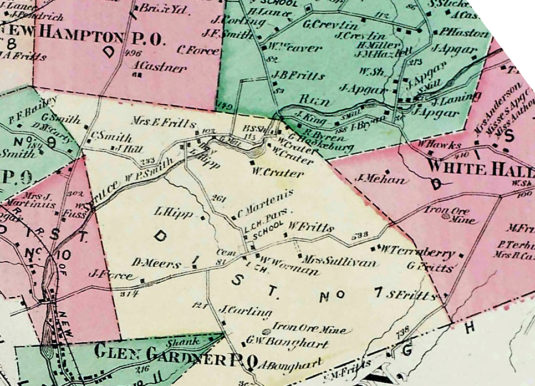
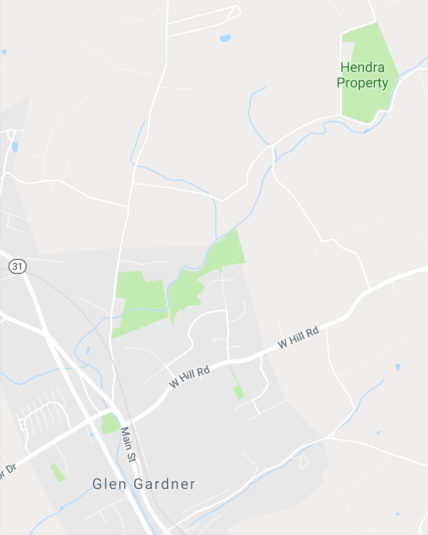
The Hunterdon Republican took note of the death of William’s wife Caroline, reporting on February 8, 1877 that “Mrs. Wm. Crater,” who died on January 31, 1877, “was buried in the Spruce Run Cemetery on Saturday.” Surprisingly, the paper made no mention of Crater’s subsequent marriage to Sarah Aller, which happened on July 12, 1879.7 There may have been a reason for that. 1879 was a terrible year for William Crater.
It appears that Crater had not been wise when he financed his land purchases, and by early 1879 had gone bankrupt. On February 27th, he assigned all his property, and I mean every last bit of it except the clothes on his back, to Edward Humphrey.8 The conveyance included all his real estate, goods & chattels, bonds, notes, books of account, contracts rights and creditors whatsoever, in trust to be sold to satisfy his creditors. An inventory was included with the deed, showing a total value of $8,284.75. It included a farm of 92 acres, the blacksmith shop & lot, and other small lots.
Edward Humphrey
Edward Humphrey was a good choice for this job. He had taken over the Eveland Hotel in 1868, and prospered mightily. According to the handout available at the Hotel, which is still very much in operation today, Humphrey was known as a politician and a wheeler-dealer, but also as a generous man. I am certain Crater put a great deal of trust in him.
Here is a photograph of Humphrey’s Hotel taken around 1900 (downloaded from Facebook) and another of the same hotel today.
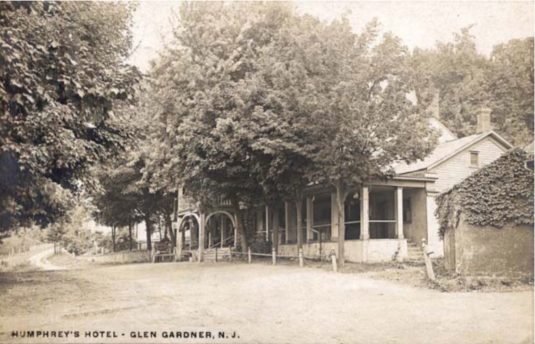
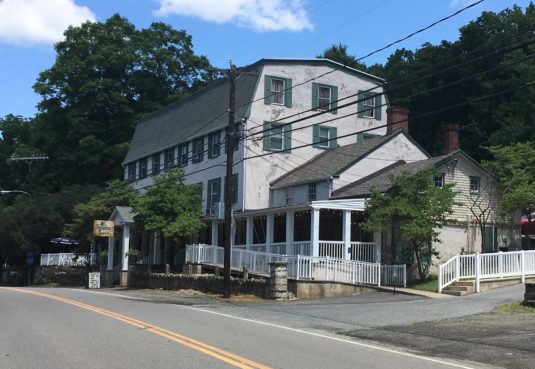
Because I live in the southern part of the county, I do not often travel the north county roads, and haven’t been to Glen Gardner for many years. Recently, husband and I took a trip up there, and I must say it is a charming town, with lots of wonderful old houses. And the topography in that neck of the woods is pretty exciting.
One of the most interesting houses is far grander than any other in the village. It belonged to Edward Humphrey, of course.
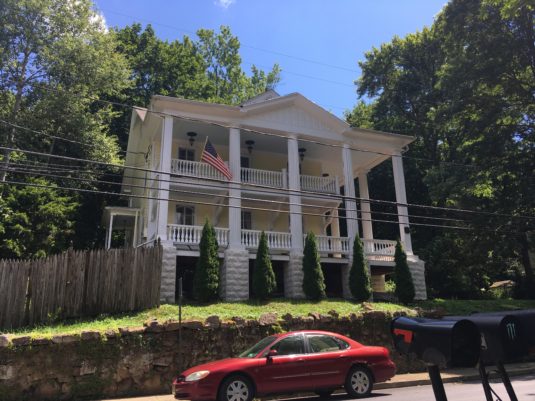
On October 16, 1879, the Republican, which had previously announced Crater’s assignment to Humphrey, published Humphrey’s notice of the sale of Crater’s real estate, to be held on November 3, 1879. It consisted of:
No. 1: a Farm of 94 & 21/100 Acres of land, adjoining lands of Peter Martenis and others. (This was his father’s farm.)
No. 2: A Lot in Lebanon Township of about 15 Acres.
No. 3: a Wood Lot of about 10 Acres.
No. 4: A house Lot, Wheelwright and Blacksmith Shop, wherein said Crater now resides. (This was the lot seen in the Beers Atlas, above. Until I saw this notice, I had no idea that Crater was also a wheelwright.)
No. 5: A Lot of 8 Acres, and No. 6: A small Lot adjoining No. 4, of about 3/4 of an Acre.
Sadly for Crater’s creditors, the sale of the 94-acre farm was bid at only $25 per acre. The sale was adjourned and postponed a week but it was not purchased until August 1880, when it was sold, along with the 15-acre woodlot to Abraham Reiner.9
It occurs to me that the reason the Republican did not announce Crater’s marriage to Sarah Aller is that the couple had left town, and who could blame them. I have two reasons for thinking so. First, Crater does not appear in the 1880 census for Lebanon Township. The second reason is another item from the Republican, dated December 29, 1881:
We congratulate John Eveland for illuminating the street in front of his house these dark nights. Others are preparing to follow his example. The lamps are a gift from William Crater of New York, who visited our town recently.
If Crater could afford to be making gifts to his home town only two years after his financial disaster, then he must have found a very quick way to make a buck in the Big Apple. But what that was I cannot say.
By March 1882, he was doing some work for Hunterdon County. The Republican reported that the Freeholders’ account showed $2.63 paid to Wm Crater for “repairing.” Presumably Crater had moved back to Lebanon Township by then, was probably living in a rented house. In 1884, the Republican announced the sale of a lot of 6.67 acres by the estate of Philip Haston, dec’d, one of those who had purchased some of Crater’s property back in 1880. The lot bordered lands of Andrew Castner and Robert Bryan, and was known as “the Lot of William Crater.” It was located on the road from Apgar’s Mill to Glen Gardner. I’m pretty sure that was the previous location of Crater’s Blacksmith Shop.
Sometimes Crater’s appearance in the Republican had nothing to do with properties. In June, 1884, “A snapping turtle weighing about 20 pounds was caught in a pond by William Crater of Lebanon Tp.” In the New Jersey Census of 1885 for Lebanon Twp., William Crater was sharing his household with Sarah Crater age 20-60, Jennie 20-60 and Nellie 5-20. (The NJ State Census collected far less information than the federal census did.)
In 1886, Crater relocated. On March 24th, the paper announced that “Wm Crater will occupy the Foss lot.” The word occupy makes it clear that Crater was renting, not owning. Most likely that lot had been owned by George Foss (1798-1877), who had acquired quite a bit of property during his lifetime, some of which was still being sold after his death. But none of his land was sold to William Crater. It seems that Crater had learned his lesson and was no longer investing in real estate.
Crater’s decision to relocate to the Foss lot seems to have been a good one, as his business really took off after that. In 1889, the Republican reported that Samuel Carr “who worked for William Crater, the blacksmith, 29 years ago [in 1860], is again working for him. Mr. Crater is overrun with work.”
The downside of being successful is that it attracts the wrong sort of people. In the 1880s and 90s, Crater was robbed repeatedly. Here is the first mention of it:
1890 May 7, In a few years, John Eveland ought to be a millionaire. His farm seems to be one mass of manufactured mineral articles of all kinds. On Saturday, his farmer unearthed the following articles while plowing: one half inch socket chisel, one screw driver, one rasp, 14 five inch bolts, 2 linchpins, 3 staples, one shoemaker’s pincers, one pair hopples, 2 pole straps and 1 axe.
These articles were apparently placed in one pile and then ploughed under. The bolts and hopples belonged to William Crater. The bolts had never been used. These and a small wrench had been stolen from his shop. He also had an axe and several other articles stolen. . . . This field was along the road to Wood Glen and had not been ploughed in 3 or 4 years. Other fields on the farm have yielded chains, crow bars, etc. and in one instance a pine board and a wagon seat. The question is, how could a man plough under such articles and not know it? About the time these articles were ploughed under, considerable stealing was going on in this vicinity.
A couple weeks later, Crater went fishing with some friends and made a troubling discovery:
Death by drowning, on May 22, 1890, Charles Daniels, about 19 years of age, of Stanton. He was employed by James J. Losey, who lives about 2 miles north of Flemington. Mr. Losey, Mr. Daniels and William Crater had gone fishing in the South Branch near Stover’s Mills. They were out in a boat when it started to leak. They tried to get to shore but the boat sank and all three went in the water. Losey and Crater were able to get to shore, but Daniels could not swim and he sank and drowned before help could be summoned.10
According to the Republican of January 21, 1891, Crater finally bit the bullet and bought a house lot. “Harvey Davis of Glen Gardner, sold the house and lot opposite the Clarksville Academy to William Crater, blacksmith, of Glen Gardner.” But no deed was recorded until 1898, when Davis and wife Kate conveyed the lot to Sarah Crater for $300. It bordered the public road, a factory lot, and other land of Harvey Davis.11 Why was it sold to Sarah rather than William? Probably because like so many other men who got into trouble with creditors, it was safer to put it in his wife’s name. Later items in the Republican make it clear that the lot was adjacent to Harvey Davis’ store.
Then came another instance of robbery.
January 28, 1891: William Crater does not mind the loss of his fine Brahma hen, but is anxious to have the person who walked away with her, to inform him whether or not she was fat.
It is not clear from the paper, but it seems likely that Crater had decided to build himself a new blacksmith shop on that lot he had bought from Harvey Davis. On the same day as the incident of the Brahma hen, the Republican announced the “William Crater has begun building a 2 story blacksmith shop, 30 x 20 feet.” And on March 18, 1891, “The blacksmith shop of William Crater is complete except for the painting. His house is enclosed and nearing completion.” And less than a month later, on April 8th, “William Crater is snugly fixed in his new blacksmith shop.”
Sometimes Crater’s customers gave him trouble. Take Solomon Swartswood who “was indebted to Crater for blacksmithing.”
The latter gave him a carpet to weave, expecting the work to be in payment for the blacksmithing. Swartzwood would not have it that way, but held the carpet, besides presenting an extraordinary bill against Crater. Hence the trouble between them.
This was reported in the Republican on June 10, 1891, which announced that “the difficulty between Solomon Swartswood and William Crater was settled by arbitrators,” but the paper did not describe the settlement.
The work of a blacksmith was hazardous. The newspaper reported on July 1, 1891 that Crater “while handling a hot iron on Friday, accidentally burned his arm.” And on May 11, 1892, the readers learned that “William Crater is not able to work in his blacksmith shop at present, due to a bout of rheumatism in his shoulder.”
The blacksmith’s wife had her own problems. The paper had reported on December 30, 1891, that Mrs. Crater was among those suffering from “La Grippe,” i.e., the flu. On April 5, 1893, she was “quite ill with neuralgia.”
The following week, the Republican announced that “Martin Kaffitz occupies the Bell homestead. He is employed in the blacksmith shop of William Crater in Glen Gardner.” It also reported on May 9, 1894, that Kaffitz would continue at the shop for the coming year.
Then, more trouble in the Crater household and more robberies:
1893 July 12, The little boy of William Crater had his toe mashed the other day by a piece of iron falling on it.
1893 October 18, William Crater was quite sick last Wednesday, but was able to be out again by Saturday.
1894 January 3, Thieves entered the dwelling of William W. Swayze on Friday night. They gained entrance by breaking a window and ransacked the drawers and cupboards, taking about $100 worth of items. They took his overcoat and a watch belonging to his daughter, Minnie. They tried to enter the store of Harvey Davis by boring a hole in the rear door, but were unable to get in. They had broken into the blacksmith shop of William Crater, and stole the tools that they used in their successful and attempted robbery.
1894 May 9, The store of Harry Davis of Glen Gardner was burglarized on Saturday night. Tobacco, cigars, wheat flour, shoes, a watch and other articles were taken. The blacksmith shop of William Crater was also entered the same night and tools taken.
1896 January 1, Thieves have visited this area again. On Christmas night, the spring house of Samuel Apgar was broken open and a small quantity of eatables were taken. The same night, the barn of John Smith, who works for Joseph Fritts, near Spruce Run Church, was entered and a quantity of cornstalks were taken. The same night, the blacksmith shop of William Crater was broken into and tools were taken.
1896 May 13, Burglars blew open the safe in the office of Reeves & Son, on Saturday night and took about $20 worth of goods and a few pennies. The butcher shop of Christian Krauss was broken into and a quarter of meat was taken. And as usual, the blacksmith shop of William Crater was burglarized of the tools used in the other robberies.
Note the expression, “as usual.”
The Hockenburys
In 1895, William and Sarah Crater welcomed an elderly couple into their home. They were Conrad and Sarah Hockenbury.
1895 January 2, Conrad Hockenbury and wife Sarah are now making their home with William Crater in Glen Gardner. Mr. Hockenbury is 93 years old and his wife is 91 years old. They were former neighbors of Mr. Crater, years ago, living near Newport.
I cannot say where Newport was. Perhaps near where Crater’s original blacksmith shop was located. In fact, by looking closely at the detail from the Beers Atlas, one can see right above Crater’s name, the unusual name of “G. Hookeburg.” It was common for map makers unfamiliar with the area they were mapping to use phonetic spelling for the names they were given. This seems likely to have been a corruption of C. Hockenbury.
It was difficult to find information on the Hockenburys. Conrad Hockenbury was born March 10, 1802 and married wife Sarah Stevenson (or Sarah McPherson) on December 19, 1835. She was born in February 1804.12 The only census record for this couple I found was in 1880 when the couple was living in Lebanon Township, Conrad being 77 years old and Sarah 75. There was no one else in their household, but Conrad was still employed as a blacksmith at that advanced age. That could be the connection with William Crater, who may well have apprenticed to Conrad Hockenbury.13
Since the Hockenburys were already in their 90s when they moved in with the Craters, it is not surprising that they both died the next year.
1896 February 26, Death at the home of William Crater in Glen Gardner on 21 Feb. 1896, Conrad Hockenbury, aged 94 years. He leaves a wife, Sarah Hockenbury of Glen Gardner, who is 92 years old.
1896 November 25, Death at the residence of William Crater, in Glen Gardner, on 17 Nov. 1896, Mrs. Sarah Hockenbury, aged 92 years and 9 months. She was the widow of Conrad Hockenbury, who died earlier this year at the age of 94.
Crater’s Last Years
The village of Glen Gardner was beginning to prosper and Crater joined in the improvement effort. In December 1894, “William Crater has put down a sidewalk in front of his residence,” as reported in the Republican on Dec. 12th. The following year, he installed a well there. The Republican reported on December 4th that “at the depth of 13 feet water came in so fast that work was stopped for a few days.” The same issue of the paper reported that “Edward C. Shuler of Warren Co., has quit blacksmithing for William Crater, and Martin Kaffitz has taken his place.” This was when Kaffitz had returned from his sojourn in Germany.
The late 1890s were full of trouble for the Craters.
1896 July 8, William Crater ran a bit through his right hand on Friday, while drilling a piece of iron.
1897 January 6, Mrs. Crater, wife of William Crater of Lebanon Tp., has been very sick with pneumonia the past week.
1898 March 9, Death from heart disease, at Glen Gardner, on 27 Feb. 1898, Mrs. Sarah C. Crater, aged 52 years and 5 months. She was the wife of William Crater of Glen Gardner.
The death of Sarah Aller Crater left William Crater solely responsible for their two children. In the census of 1900 for West Lebanon Twp., (i.e., Glen Gardner), William Crater was 75 years old, born in February 1825, widowed, a blacksmith who owned his house. Living with him were his daughter Lela E. Crater 14 and son William Crater 9, who were both at school. Crater also had a boarder, one Russell Stires age 17, who helped in the blacksmith shop. But there was no one to help with maintaining the household or caring for the children. That burden must have fallen on 14-year-old Lela, or else Crater hired a housekeeper who did not live with the family.
Time was running out for William Crater. In December of 1900, he was reported in the Republican has having “had two very bad attacks last week and remains quite feeble.” He died on February 12, 1905, age 81, and was buried in the Spruce Run Cemetery next to first wife Caroline Waters.
I cannot report on his obituary because the abstracts of the Republican by Bill Hartman end before 1905, and a search on Google yielded nothing at all. But it is clear that he led an interesting life and despite his mid-life bankruptcy was an important member of the community of Glen Gardner in the 19th century.
Children of William Crater and Caroline Waters:
- Margaret Jane Crater, born abt 1847, died 1853, age 6
- Mary E. Crater, born abt 1848, died before 1860
- George W. Crater, born 1850, died 1933, married Mary Shadrack Force
- Emma Armina Crater, born 1857, died 1935, never married
- John Waters Crater, born 1860, died 1947, married Matilda C. Klute
- Lillie Stevenson Crater, born 1865, died 1885, never married
- Jennie A. Crater, born 1865, died 1943, never married
Children of William Crater and Sarah Aller:
- Liliah E. Crater, born 1885
- William Hiram Crater, born 1890, died 1951, never married; lived with the family of William and Jennie Struble.
A Note of Appreciation: I am very grateful to Bill Honachefsky for helping me become better acquainted with the vicinity of Glen Gardner.
Footnotes:
- According to Snell’s History of Hunterdon County, p. 447. ↩
- H. C. Deeds Book 121 pp. 428, 430, 432, and Book 126 p. 768. ↩
- H. C. Wills, Book 11 p. 518. ↩
- He was not listed in John W. Kuhl’s book on Hunterdon County in the Civil War. ↩
- This was probably a conveyance from the heirs of the estate, even though no deed was recorded. ↩
- See the Martin Kaffitz story for more about Stewart Bell. ↩
- I have not succeeded in identifying Sarah Aller’s family. ↩
- H. C. Deed Book 180 p. 253. ↩
- H. C. Deed Book 189 p. 307. This deed explained that it had been conveyed to Crater by Joseph Bonnell on March 29, 1870, but gave no citation for a deed. It was probably done as part of the estate. For further research, one can visit the Surrogate’ Court and view records of the Orphans Court, where Edward Humphrey recorded his account of the Crater properties. Disposing of his properties was complicated by lawsuits brought by some of Crater’s creditors in the Court of Chancery. ↩
- Hunterdon Republican, May 28, 1890. According to the 1880 US Census, the victim’s mother was Mrs. Henrietta Daniels of Stanton. ↩
- H. C. Deed Book 249 p.552. ↩
- Birth dates come from the couple’s gravestones. ↩
- The newspaper notices are pretty confusing about where Conrad was living. In 1882, he was “of Annandale,” but in 1883 he was “of Lebanon Township.” Then on July 18, 1888, a story was published in the Republican concerning property in Mount Airy that Hockenbury owned. “George Reed, a blacksmith and his wife, who reside near the Mount Airy School House, were arrested on Saturday, . . . under the charge of unlawfully obtaining property from Andrew Anderson and others. Conrad Hockenbury owned a house and lot near Reed’s place, which he sold to Mr. Anderson.” my emphasis. ↩
Larry Dabkowski
September 27, 2020 @ 2:09 pm
I remember growing up in Glen Gardner, as a small child, meeting a well known Blacksmith who lived and worked in Glen Gardner in late 1950s and early 1960s, his name was EKIE, His shop was located near the ORIGINAL Glen Gardner Firehouse, he looked and dressed like the old WagonTrain (20 muleteam Borax) show in the early 1960s prospector character, never forget him